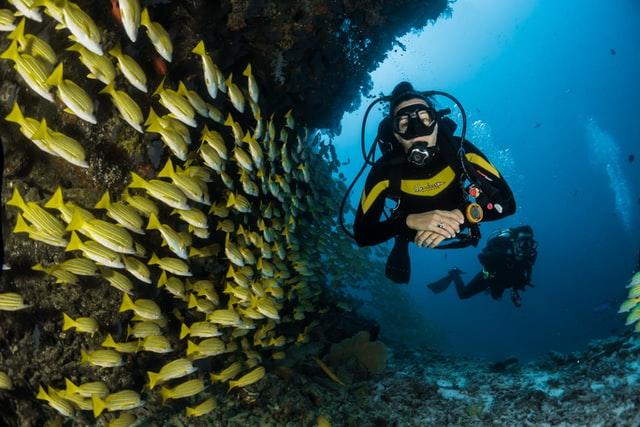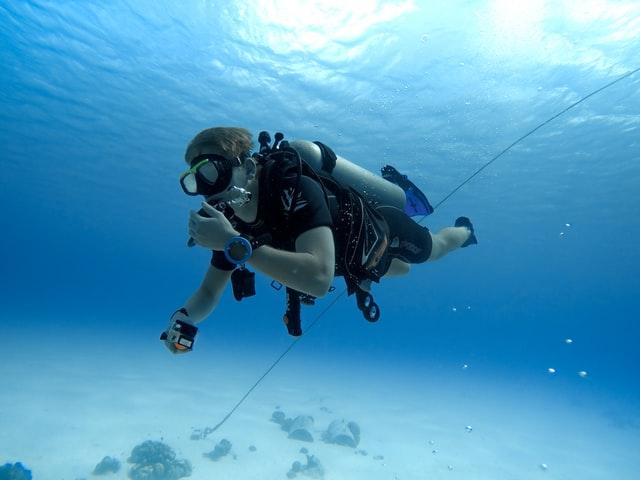What are the Best Dive Compasses?
When you are headed deep sea diving, it can be difficult to keep track of directions hundreds of feet beneath the surface. This is why most professional divers, or at least those that don’t like being lost, use a dive compass so they can know which direction they are headed.
Not all dive compasses are created equal, however, so read on to learn which are the best as well as some tips you can keep in mind as you select a dive compass.

The Best Dive Compasses
There are many different types of dive compasses, some of which are more budget-friendly, but remember that cheaper is not always better when it comes to a piece of equipment you want that could keep you from wandering in the wrong direction underwater.
Here is our list of the best dive compasses. Read the information carefully to see which one you think will work best for you during your deep sea dives. And remember, there are much more important things at stake besides the price!
Oceanic Dive Compass
The oceanic dive compass is an ideal compass for beginning divers, but only if you are diving in the northern hemisphere. With an easy-to-read face and a strap that can easily attach to your wrist, this compass makes it easy to find the direction you are looking for.
Out of all of the compasses on our list, this one is the easiest to see in the dark, mostly thanks to the OceanGlo card, which can absorb light much better than most other materials. The compass also responds quickly, with less lag time than other diving compasses on the market.
Check the direction via the top panel or the side panel, whichever is easiest for you. While this compass isn’t cheap, it is cheaper than some other options, and we do think that it is a good value for the price. It is also lightweight, so you won’t feel like there is something bulky on your wrist as you dive.
Pros:
- Good value
- Wrist mount
- Responsive
- Good lighting in dark waters
Cons:
- North hemisphere only (not for traveling divers)
- Pretty basic, all things considered
Sheerwood Dive Compass
Only slightly more expensive than the oceanic dive compass is the Sherwood Dive Compass, but for a few extra dollars, this compass is calibrated for both hemispheres, making it a better choice for a diver who likes to travel to dive in warmer waters.
This compass comes in a retractable mount, however, so if you would like to wear it on your wrist, you’ll have to spend a little extra money to purchase a wrist strap. Otherwise, this compass clips to your BCD nicely.
Out of all the compasses on this list, this one is the most responsive and is very accurate–therefore, we highly recommend it for divers who are completing highly technical dives. Plus, this compass is quite durable, so no need to worry about breaking it!
Pros:
- Very accurate
- Durable
- Responsive
- Easy to use while in motion
- Clear markings
- Calibrated for both hemispheres
Cons:
- BCD mount only
Suunto Sk8
The Suunto Sk8 is one of our favorites when it comes to diving compasses. At a price point that is just in between the two diving compasses listed above, this option gives you lots of value for the cost.
The Suunto Sk8 is ideal for someone who wants to navigate on this go, this is because the compass is rated to work with a tilt angle of up to 30° without tumbling. This means you can easily use it while walking and don’t have to worry about compass tilt errors.
While the phosphorescent card in this compass isn’t quite as good as that in the oceanic dive compass, you will still get quite a bit of underwater visibility even when it is dark. One thing we love about this compass, in particular, is that it comes with a wristband and a BCD attachment, allowing you to use it however you please.
Pros:
- Calibrated for both hemispheres
- Wrist mount or BCD mount
- Works with large tilt angles
- Responsive
Cons:
- Less bright than other dive compasses
Cressi Dive Compass
The Cressi Dive Compass is the most basic on this list. It’s inexpensive, but you won’t get near as many nice features as you have with the aforementioned compasses. But for the price, this is a decent option.
The Cressi compass is easy to read and can be mounted either on your BCD or wrist. It’s also durable and won’t break if you drop it from everyday heights.
The only problem with this compass, as far as we can tell, is the fact that the illumination feature doesn’t work all that well, so if you are headed for some dark dives, you’re better off picking another compass.
Pros:
- Inexpensive
- Durable
- Easy to read
- BCD or wrist compatible
Cons:
- Illumination isn’t that great
- Must be used while flat (no tilt protection)
Aqua Lung Wrist Compass
The Aqua Lung Wrist compass is one of our favorite diving compasses for your wrist. It has large numbers which are easy to read, and illuminates when the visibility is low.
Why do we love this compass so much? Mainly because it has shown to be accurate even with 80° of tilt which is almost unheard of for a dive compass.
While we do love the wrist strap this compass comes with, you can easily pop the compass out and attach it to a retractable compass holder for those who prefer to attach their compass using another method. This compass isn’t the cheapest on our list, but it isn’t the most expensive either, meaning getting a second attachment should be no problem.
Sadly, this compass is only for the Northern hemisphere, so not the best for a travel diver, but otherwise it is a great deal, for what you get.
Pros:
- Wrist attachment with other options
- Large print numbers
- Works when tilted
- Illuminates
- Decent price point
Cons:
- Only for Northern Hemisphere
Trident Retractor Compass
The Trident Retractor Compass is one of the best retractor options for those on a budget because while it is retractable, the two foot included cord is durable, ensuring you won’t accidentally lose this compass during a retraction.
It attaches via a clip to any piece of gear you would like. It’s scratch resistant, and you can read the numbers either from the side or the top–whichever you prefer. This compass is luminescent but not as much as some of the other compasses on this list.
The major issue with this compass is that you must watch the tilt angle. Unfortunately, when this compass is tilted, it does not read direction correctly. If you are looking for a more accurate compass while in motion, then it’s best to choose another one from this list.
Pros:
- Inexpensive
- Scratch resistant
- Best retractable mount we’ve seen
- Two foot durable cord included
- Readable from the top or side
Cons:
- Only works when flat
- Only for the Northern Hemisphere
Tips for Choosing a Diving Compass
As you can see, there are many different choices when it comes to a diving compass, so how do you know which one is right for you? Below are some tips to help guide your decision.
1. Know Where You Will Dive
On our list, there are a few diving compasses which are only for the Northern hemisphere, which, if you are an American or British diver, this may be sufficient for you. But what if you want to dive in the warm waters of Bali someday?
Bali is in the Southern hemisphere, meaning you would need a new compass for that trip. While you will likely be renting gear anyway, it is just something to keep in mind. Most traveling divers choose a compass that is rated for both hemispheres.
2. Know What Visibility You Will Be Facing
Different dive compasses have different levels of luminescence. While those staying in lighter, warmer waters may have enough with some light luminescence, those who are heading deep under the water will need some serious light and the basic compass likely won’t be enough for them.
3. Watch How it is Mounted
If you are just getting started with diving, you may not know which form of compass mount is better for you. Therefore it might be better to get one that can be mounted in different ways so you can see which you prefer. While you can just buy a wrist one, this can be a heavy commitment for someone who is just starting out!
If you already know which mount you prefer, then your decision is much easier, unless you would like to try something new of course!
4. Know Your Vision
Some people have better vision than others, it’s just how life is. Being aware of your own vision capabilities when choosing a diving compass is important, as it will guide you to the size of printing you should look for. If you struggle with seeing on land, then a bigger print is probably better for when you are underwater!
If you have perfect vision, then this likely won’t be an issue for you!
5. Price Point
As we mentioned earlier, you should never just buy the cheapest diving compass, especially if you already have a purpose in mind. For example, if you want to deep sea dive, the cheapest compass on this list will not cut it as you will be unable to see it in the low visibility.
Instead, we implore you to buy the compass which is best for you. But if you are deciding between two that have the exact same capabilities and durability, then, of course, choose the cheaper one.

How to Use an Underwater Compass
Wondering how you use an underwater compass? Here’s our step by step guide.
Step 1: Become Motionless
Most underwater compasses don’t work when you are moving, therefore to use one, you need to become as motionless as possible. Check your buoyancy as you do so to ensure you aren’t floating from your current position.
Step 2: Hold the Compass Properly
Hold the compass flat, but where you can view the numbers. Point the lubber line towards your target.
Step 3: Check Your Compass
Once the lubber line is lined up, move the compass back and forth while level. The car should remain where it is. If it moves as you do, your compass is busted.
Step 4: Count Tick Marks
Next, count the tick marks between the lubber line and your closest cardinal point. Once you have that number, shift the compass back and forth one final time to double check accuracy.
Now you know which direction you need to go and how far you should turn in that direction!
FAQs About Diving Compasses
Do Compasses Work Underwater?
Any magnetic compass will work underwater, however most compasses for hiking are not luminescent, meaning it may be difficult to view the numbers where the visibility is poor. For this reason we recommend purchasing a diving compass.
How Do You Navigate While Diving?
Navigating while diving is best performed using a diving compass, however for shorter dives that are close to shore, divers may use landmarks to know where they are headed.
How Do You Tell Which Way is Up Underwater?
The best way to tell which way is up underwater is to look at your dive computer or depth gauge. If these are not available to you, ascend slowly in the opposite direction of the drops of water on your mask (the water droplets will always go down).
Do You Need a Compass in Addition to a Dive Computer?
Using a dive computer is not enough, you will also need an underwater compass to use in addition to your dive computer to navigate while underwater.
Link/Reference This Article
If you found the information in this article useful in your research, please link to use as the source using the tool below.
-
<a href="http://seatemperatures.net/blog/best-dive-compasses/"> What are the Best Dive Compasses?</a>
-
" What are the Best Dive Compasses?". SeaTemperatures.net. Accessed on April 29, 2024. http://seatemperatures.net/blog/best-dive-compasses/.
-
" What are the Best Dive Compasses?". SeaTemperatures.net, http://seatemperatures.net/blog/best-dive-compasses/. Accessed 29 April, 2024
-
What are the Best Dive Compasses?. SeaTemperatures.net. Retrieved from http://seatemperatures.net/blog/best-dive-compasses/.
